|
Coral
Fusion and Grafting
The great soup of life known as the
ocean continues to surprise us with all its mysteries that
we gradually uncover. I am continually amazed by life's tenacity,
surviving in any way it can. Life indeed knows no bounds,
including those of the neat, linear organization we try to
impose on it. Interspecies and intergeneric hybrids, fused
colonies and chimeras
are par for the course.
Life doesn't care about species distinctions or about the
distinction between separate animals, to a point. What keeps
your Acropora from growing into and fusing with your
Montipora? It's called self / non-self recognition.
Corals, as well as many invertebrates and vertebrates, have
the ability to distinguish between their own tissue and that
of another species or another animal of the same species.
If there were no such recognition, everything would grow and
fuse with everything else. This recognition allows the animal
to retain its distinction as a separate animal in its surroundings.
It is, in short, an immune system.
There are three types of fusion among corals: 1) Isogeneic
fusion, which is the fusion of coral with genetically
identical tissue, such as branches of Acropora fusing
into each other, 2) Allogeneic fusion, which is the
fusion of genetically different corals of the same species,
and 3) Xenogeneic fusion, which is the fusion of entirely
different species or genera; this may lead to the formation
of a chimera.
Looking at the pictured Trachyphyllia open brain (left)
in the aquarium, I asked myself, "How did this happen?"
It looked as if someone took two completely different colored
corals and seamlessly glued them together. Later, I learned
how corals can fuse with other fertilized eggs just after
fertilization (Veron, 2000), and this may begin to explain
the perfect half-and-half situation of the above pictured
open brain. Another type of fusion occurs when two or more
coral planulae settle near each other, eventually growing
into one another and fusing to form a larger colony, often
resulting in a coral with clear distinctions where the original
colonies fused. As they grow, or if more than two colonies
fuse, the distinctions can be blurred; often, though, it's
difficult to distinguish where one ends and the next begins.
It has been shown that Pocillopora damicornis larvae
will readily fuse with other larvae of another variety of
Pocillopora damicornis (Hidaka, 1985). This is perhaps
that same thing happening with the Trachyphyllia.
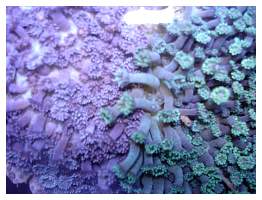 |
Another example of this phenomenon can be seen in a colony
of Goniopora I recently received (photo above). It
too was split half-and-half with one side being a purplish-brown
color and the other side green. Upon closer inspection of
the boundary between the corals (photo below), I could see
that some of the individual polyps contained both of the colors,
and the corallite walls were seamless between the two halves.
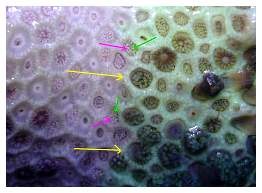 |
Corals of the same species often fuse their tissue and grow
into one larger colony. Sometimes two closely-related corals
grow right next to each other and meet up. They remain separated,
however, but because they are so closely related they do not
kill each other. Often zoanthids are available with many color
morphs, possibly representing different genotypes, existing
side-by-side on the same rock. When examined closely, the
different kinds do not actually fuse but live side-by-side.
While there is probably competition between the several varieties,
they don't destroy each other like a Euphyllia would
do to a Montipora.
I find this delicate dance between corals exquisitely beautiful.
We all love pictures of corals in the wild, with dozens of
different species packed together in ways most aquarists wouldn't
dare attempt with their prized subjects. Coral combos are
big sellers; the most commonly available are zoanthid combo
rocks. It seems an almost infinite variety of colors can be
found together on one rock.
For me, the creation of these combos is an art. The correct
balance of hue, texture, the overall composition and how it
draws the eye around the whole piece is what really makes
a particular piece beautiful. I am easily bored, though. I
was more excited by the Goniopora and Trachyphyllia
fusion than by any other combination I've seen in a long while.
So, I did what any reef farmer "artist" would do.
I grabbed my Dremel! I was so intrigued by these natural fusions
that I wanted to give it a try myself.
It's generally known that grafting different plants together
is nothing new. Go buy almost any rosebush; it will have the
root system of a hardy wild-type rose and the top consisting
of a beautiful variety. This is often done because the new
cultivated varieties don't have roots as strong and fast growing
as those of the wild type. You can buy fruit trees with four
different kinds of fruit, or flowering trees, half-pink, half-white.
So, grafting corals? What!? Why!?!
Well, why not? If chosen carefully, the problem of one coral
irritating the other will not occur. I decided to start this
fusion adventure by experimenting with the genus Acanthastrea.
I chose two varieties of Acanthastrea echinata, both
of a similar form. One consisted of basic browns with a bit
of green scattered about here and there. The other was bright
orange with blue streaks. I cut a fragment of both, each having
about four mouths. I made sure the sides where the potential
fusion would take place were as flat as possible. I then glued
both to a plug so that the flat sides were touching each other.
After the first week I was relieved to see that they had indeed
not killed one another.
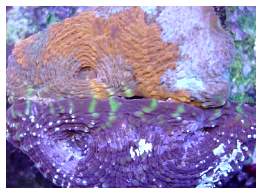 |
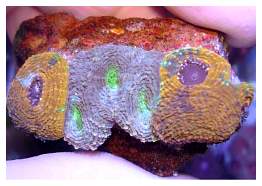 |
I then tried the same procedure with two corals in the family
Fungiidae. I did not identify them down to the species or
genus level, but just noted that one was orange, the other
green. I cut each in half with a Dremel and used small amounts
of super glue gel toward the bottom of the fragments' wounds.
After two days I noticed that the green was dying at the meeting
of the coral, and the orange was unaffected. I then separated
the corals. There are many species of plate corals in several
genera, and this mix was apparently not a compatible one.
A closer inspection, in order to graft the same or closely-related
species, seemed to be necessary.
All of my subsequent graftings were successful in that no
more corals were found to be incompatible. I had more Acanthastrea
lordhowensis at my disposal than just about any other
single species, and thought how pretty it would be to see
all those colors together. The drab purplish-brown colony
looked quite lovely when contrasted with blue, green and red.
For one grafting I cut two polyps in half and then glued them
together. They ended up forming their own mouths and not immediately
fusing together as I had originally hoped. Also, with many
Echinophyllia at my disposal, I grafted several varieties
together. The Christmas season was screaming for some red
and green fusion, and I was happy to oblige.
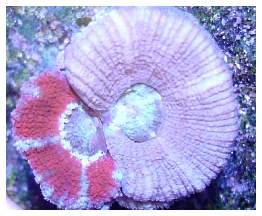 |
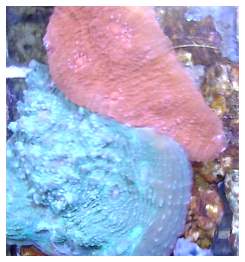 |
I decided to apply these methods to some of the Goniopora
in my care. I grafted together several varieties of Goniopora
tenuidens to one another (allografts). I then tried my
hand with green and red Goniopora burgosi and Goniopora
stutchburyi. I also did one interspecies grafting (xenograft)
between Goniopora norfolkensis and Goniopora planulata.
At the time of this writing these graftings have not fused.
No direct competition such as stinging is obvious between
the graftings, but it's possible they may be involved in unseen
chemical warfare. A careful study of grafted and non-grafted
specimens will need to be carried out to determine if this
is the case.
My results echo findings from several scientists. These include
grafting experiments on gorgonians in the wild (Bigger, Runyan
1979), Acropora and Porites (Hildemann, Linthicum,
and Vann, 1975) and more recent experiments with Seriatopora
(Nozawa, Loya 2005.) Isografts often formed quickly and fusion
was fast. It was found that allografts did not form stable,
long-term fusion between the colonies. There eventually was
tissue separation, if it even took in the first place. Xenografts
usually resulted in no fusion or one coral dominating the
other and/or a large area of dead tissue between the colonies.
At the start of this series of grafting I was expecting full
fusion from allografts (grafting genetically distinct corals
of the same species.) However, after noticing the results
of my graftings and reading a large stack of papers on the
subject (thanks, Eric), it seems this coexistence but lack
of fusion is the best that one can expect among allografts
in the adult stage. However, I plan to try more grafting in
the future to determine if colony size plays a role. Juvenile
corals have been shown to more readily accept allografts and
xenografts (grafting of separate species or genera) (Hidaka,
1985; Nozawa, Loya, 2005). I will use very small tissue samples
to see if I can get the same reaction as seen in larval and
juvenile corals. It should be noted that in these experiments
the corals did not form stable chimeras and separated as they
matured and their alloimmune system kicked in.
In one series of experiments published in the paper, "Transplantation
and Immunoincompatibility Reactions Among Reef-Building Corals"
(Hildemann, Linthicum, and Vann, 1975), much work was done
with Acropora formosa and Porites andrewsii.
They found that intracolony isografts consistently formed
strong compatible fusions. However, they found allografts
and xenografts did not form long-term fusion of soft tissue.
In allografts there was initially some soft tissue fusion
where they were forced together in the first few weeks, but
they then separated their soft tissue with their hard tissue
remaining fused. When there was not forced contact, there
was none of this initial fusion. In xenografts there was no
soft tissue fusion and the corals secreted a layer of skeleton
to separate the soft tissues. It was noted that this cementum,
as it is called, is quite similar to the cementum corals use
to anchor to a substrate.
While there have not been any long-term, stable allografts
produced by grafting, the previous examples of the half-and-half
Trachyphyillia and Goniopora lead me to believe
it is possible. The aquaculture of coral is in its infancy.
Many techniques can be applied to coral that have already
been used for a long time in horticulture. The ocean has shown
us that these possibilities do exist.
If you have any questions about this article, please visit
my author forum
on Reef Central.
References:
Bigger C.H. and Runyan R. 1979. An In Situ Demonstration
Of Self-Recognition In Gorgonians. Developmental and Comparative
Immunology, Vol. 3. pp. 591_597.
Bigger C.H. 1988. Historecognition and Immunocompetence in
Selected Marine Invertebrates. (Richard K. Grosberg, ed.).
pp. 55-65.
Coombe D.R., Ey P.L., Jenkin C.R. 1984. Self/Non-Self Recognition
In Invertebrates. The Quarterly Review of Biology, Vol. 59.
Hidaka, M. 1985. Tissue compatibility between colonies and
between newly settled larvae of Pocillopora damicornis.
Coral Reefs. 4:111-116.
Hildemann, W.H., Linthicum, D.S., and, D.C. Vann, D.C. 1975.
Immunoincompatibility Reactions In Corals. Adv Exp Med Biol.
64:105-14.
Hildemann W.H., Linthicum D.S., and Vann D.C. 1975. Transplantation
and Immunoincompatibility Reactions Among Reef-Building Corals.
Immunogenetics 2:269-284.
Nozawa Y., Loya Y. 2005. Genetic Relationship and Maturity
State of the Allorecognition System Affect Contact Reactions
in Juvenile Seriatopora Corals. Marine Ecology Progress
Series. Vol. 286:115-123, 2005
Rinkevich B., Frank U., Bak, R.P.M., Muller W.E.G. 1994 Alloimmune
Responses Between Acropora hemprichi Conspecifics:Nontransitive
Patterns of Overgrowth and Delayed Cytotoxicity. Marine Biology.
118, 731-737.
Veron, J.E.N. 2000. Corals of the World. Australian
Institute of Marine Science, Townsville. 3 Volumes.
|

